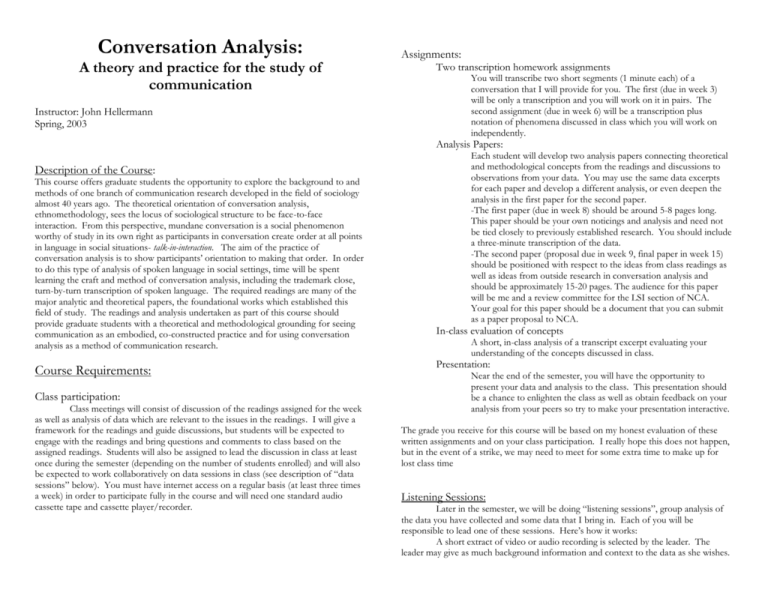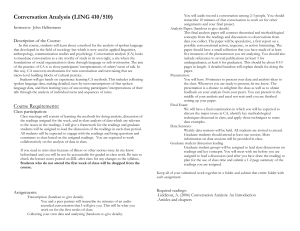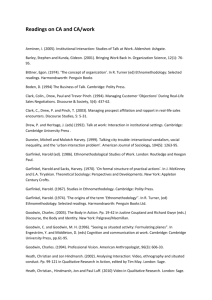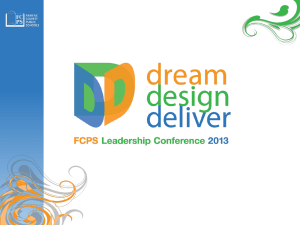Conversation Analysis
advertisement

Conversation Analysis: A theory and practice for the study of communication Instructor: John Hellermann Spring, 2003 Assignments: Two transcription homework assignments You will transcribe two short segments (1 minute each) of a conversation that I will provide for you. The first (due in week 3) will be only a transcription and you will work on it in pairs. The second assignment (due in week 6) will be a transcription plus notation of phenomena discussed in class which you will work on independently. Analysis Papers: Description of the Course: This course offers graduate students the opportunity to explore the background to and methods of one branch of communication research developed in the field of sociology almost 40 years ago. The theoretical orientation of conversation analysis, ethnomethodology, sees the locus of sociological structure to be face-to-face interaction. From this perspective, mundane conversation is a social phenomenon worthy of study in its own right as participants in conversation create order at all points in language in social situations- talk-in-interaction. The aim of the practice of conversation analysis is to show participants’ orientation to making that order. In order to do this type of analysis of spoken language in social settings, time will be spent learning the craft and method of conversation analysis, including the trademark close, turn-by-turn transcription of spoken language. The required readings are many of the major analytic and theoretical papers, the foundational works which established this field of study. The readings and analysis undertaken as part of this course should provide graduate students with a theoretical and methodological grounding for seeing communication as an embodied, co-constructed practice and for using conversation analysis as a method of communication research. Course Requirements: Class participation: Class meetings will consist of discussion of the readings assigned for the week as well as analysis of data which are relevant to the issues in the readings. I will give a framework for the readings and guide discussions, but students will be expected to engage with the readings and bring questions and comments to class based on the assigned readings. Students will also be assigned to lead the discussion in class at least once during the semester (depending on the number of students enrolled) and will also be expected to work collaboratively on data sessions in class (see description of “data sessions” below). You must have internet access on a regular basis (at least three times a week) in order to participate fully in the course and will need one standard audio cassette tape and cassette player/recorder. Each student will develop two analysis papers connecting theoretical and methodological concepts from the readings and discussions to observations from your data. You may use the same data excerpts for each paper and develop a different analysis, or even deepen the analysis in the first paper for the second paper. -The first paper (due in week 8) should be around 5-8 pages long. This paper should be your own noticings and analysis and need not be tied closely to previously established research. You should include a three-minute transcription of the data. -The second paper (proposal due in week 9, final paper in week 15) should be positioned with respect to the ideas from class readings as well as ideas from outside research in conversation analysis and should be approximately 15-20 pages. The audience for this paper will be me and a review committee for the LSI section of NCA. Your goal for this paper should be a document that you can submit as a paper proposal to NCA. In-class evaluation of concepts A short, in-class analysis of a transcript excerpt evaluating your understanding of the concepts discussed in class. Presentation: Near the end of the semester, you will have the opportunity to present your data and analysis to the class. This presentation should be a chance to enlighten the class as well as obtain feedback on your analysis from your peers so try to make your presentation interactive. The grade you receive for this course will be based on my honest evaluation of these written assignments and on your class participation. I really hope this does not happen, but in the event of a strike, we may need to meet for some extra time to make up for lost class time Listening Sessions: Later in the semester, we will be doing “listening sessions”, group analysis of the data you have collected and some data that I bring in. Each of you will be responsible to lead one of these sessions. Here’s how it works: A short extract of video or audio recording is selected by the leader. The leader may give as much background information and context to the data as she wishes. Conversation Analysis syllabus p., 2 The leader may wish to give no background information at all. After repeated listenings/viewings of the data together in class, we take ten minutes to write out the observations we have made about the data and then each student is given a chance to share observations with the rest of the class. You are also encouraged to attend the weekly listening sessions organized by the LSI faculty where students and faculty from around the university meet to do group analyses of talk-in-interaction. Required readings: -Packet of articles and chapters (for purchase from me) Calendar Readings Week 1 1/13 The goals for the semester Communication in action, talk-in-interaction Theoretical antecedents to conversation analysis: Goffman and Garfinkel Goffman, 1983 Clayman & Maynard, 1995 Week 2 1/20 Theoretical antecedents: Ethnomethodology and development of CA Heritage, 1984 Sacks, 1992 (excerpts: v. I, pp. 1-11; v. II, p. 549) Week 4 2/3 Monday, 2/3 one-minute group transcription project due Transcription workshop Issues to work on: audible in- and out-breaths, receipt tokens, laughter A turn-taking system, sequence, transition relevance , projection Sacks, Schegloff, & Jefferson, 1974 Ford & Thompson, 1996 Week 5 2/10 Analytic devices in Conversation Analysis: Adjacency pairs and Preference Sacks, 1992, v. II, pp. 521-541 Pomerantz, 1984 Sacks & Schegloff, 1979 Complete your data collection by Friday of this week Week 6 2/17 Analytic devices- recipient design, repair, structure of talk-in-interaction Guest lecture: Dr. Bryan Crow Issues in recording face-to-face interaction: permission, confidentiality, logistics Duranti, 1997 Peräkylä, A., 1997 Week 3 1/27 Transcribing data -Issues in changing mode of language from spoken to written -Handout: Transcription key Ochs, 1979 Give cassette tape to me by Monday (1/27) Transcription workshop-Building a collection Issues to work on: pauses, pause timing, overlap, unintelligible speech Jefferson, 1979 Jefferson, 1986 Jefferson, 1988 Ford & Fox, 1996 Schegloff, Jefferson, & Sacks, 1977 Friday, 2/21 one-minute transcription with analysis due Week 7 2/24 Getting started and ending Sacks, 1992, v. 2, pp. 222-228; v. 1, 685-692 Schegloff & Sacks, 1973 Schegloff, 1980 Week 8 3/3 Putting theory and method to work--Data Session Theoretical/Analytical issues- prosody Gumperz, 1992 Hellermann, 2003 Conversation Analysis syllabus p., 3 Wednesday, 3/5: In-class analysis of a transcript Friday, 3/7: Analysis paper 1 due Student Presentations Student Presentations SPRING BREAK Week 9 3/17 Theoretical/Analytical issues Talk in Institutional Settings Week 14 4/21 Theoretical issues -Gesture & Gaze Goodwin & Goodwin, 1986 Bavelas, et al, 1992 Heritage, 1997 Week 10 3/24 Applied conversation analysis: “Crosstalk” video Week 11 3/31 “Applied CA” (continued) Cicourel, 1992 Criticisms of CA Week 15 4/28 Criticisms continued, Catch up Wetherell, 1998 Cowley, 1998 Analysis paper 2 due Packet Readings C. Goodwin, 1994 (on website) Silverman, 1999 Maynard, 1991 Kitzinger & Frith, 1999 Data session- Institutional Discourse Week 12 4/7 Intercultural communication- speaking a second language/dialect Wong, 2000 Intercultural communication- language and gender M. H. Goodwin, 1999 Week 13 4/14 - Text or Context? Bavelas, J. B., Chovil, N., Lawrie, D. A., & Wade, A. (1992). Interactive Gestures. Discourse Processes, 15, 469-489. Cicourel, A. V. (1992). The interpretation of communicative contexts: Examples from medical encounters. In A. Duranti & C. Goodwin (Eds.), Rethinking context: Language as an interactive phenomenon (pp. 292-310). Cambridge: Cambridge University Press. Clayman, S. E., & Maynard, D. W. (1995). Ethnomethodology and conversation analysis. In P. ten Have & G. Psathas (Eds.), Situated order: Studies in the social organization of talk and embodied activities (pp. 1-30). Washington, DC: International Institute for Ethnomethodology and Conversation Analysis & University Press of America. Cowley, S. J. (1998). On timing, turn-taking and conversation. Journal of Psycholinguistic Research, 22(5), 541-571. Duranti, A. (1997). Linguistic anthropology. Cambridge, UK: Cambridge University Press. pp. 116121; 340-347 Ford, C. E. and S. A. Thompson (1996). Interactional units in conversation: Syntactic, intonational and pragmatic resources for the management of turns. In E. Ochs, E. A. Schegloff and S. A. Thompson (eds.), Interaction and grammar. 134-184. Cambridge: Cambridge University Press. Ford, C. E., & Fox, B. A. (1996). Interactional motivations for reference formulation: He had. this guy had, a beautiful, thirty-two Olds. In B. A. Fox (Ed.), Studies in Anaphora (pp. 145168). Amsterdam: John Benjamins. Goffman, E. (1983). The interaction order. American Sociological Review, 48(1), 1-17. Goodwin, C. (1994). Professional Vision. American Anthropologist, 96(3), 606-633. Goodwin, C., & Goodwin, M. H. (1986). Gesture and co-participation in the activity of searching for a word. Semiotica, 62(1-2), 51-75. Goodwin, M. H. (1999). Constructing opposition within girls' games. In M. Bucholtz, A. C. Liang, & L. A. Sutton (Eds.), Reinventing identities: The gendered self in discourse (pp. 388-409). New York: Oxford University Press. Conversation Analysis syllabus p., 4 Gumperz, J. (1992). Contextualization and understanding. In A. Duranti and C. Goodwin (Eds.), Rethinking context: Language as an interactive phenomenon. (pp. 229-252). Cambridge: Cambridge University Press. Hellermann, J. (2003). The interactive work of prosody in the IRF exchange: Focus on teacher repetition in "feedback" moves. Language in Society, 32(1), 79-104. Heritage, J. (1984). Garfinkel and ethnomethodology. London: Polity Press. pp. 75-84; 233-238. Heritage, J. (1997). Conversation analysis and institutional talk: Analysing data. In D. Silverman (Ed.), Qualitative analysis: Theory, methods, and practice (pp. 161-182). London: Sage. Jefferson, G. (1979). A technique for inviting laughter and its subsequent acceptance declination. In G. Psathas (Ed.), Everyday language: Studies in ethnomethodology (pp. 79-96). New York: Irvington. Jefferson, G. (1986). Notes on 'latency' in overlap utterance. Human Studies, 9, 153-183. Kitzinger, C., & Frith, H. (1999). Just say no? The use of conversation analysis in developing a feminist perspective on sexual refusal. Discourse and Society, 10(3). Maynard, D. (1991). Interaction and asymmetry in clinical discourse. American Journal of Sociology, 97, 448-495. Ochs, E.(1979) Transcription as theory. In Developmental Pragmatics. E. Ochs and B. Schieffelin (Eds.). New York: Academic Press. Peräkylä, A. (1997). Reliability and validity in research based on tapes and transcripts. In D. Silverman (Ed.), Qualitative research: Theory, method, and practice (pp. 201-220). London: Sage. Pomerantz, A. (1984). Agreeing and disagreeing with assessments: Some features of preferred/dispreferred turn shapes. In J. M. Atkinson & J. Heritage (Eds.), Structures of social action: Studies in conversation analysis (pp. 57-101). Cambridge: Cambridge University Press. Sacks, H. (1992). Lecture 1 from Lectures on conversation. (Vol. I & II). Oxford: Blackwell. Sacks, H., & Schegloff, E. A. (1979). Two preferences in the organization of reference to persons in everyday conversation and their interaction. In G. Psathas (Ed.), Everyday language: studies in ethnomethodology. (pp. 15-21). New York: Irvington. Sacks, H., Schegloff, E., & Jefferson, G. (1974). A Simplest systematics for the organization of turn-taking for conversations. Language, 50(4), 696-735. Schegloff, E. A. (1980). Preliminaries to preliminaries: "Can I ask you a question?". Sociological Inquiry, 50, 104-152. Schegloff, E. A., & Sacks, H. (1973). Opening up closings. Semiotica, 8, 289-327. Schegloff, E. A., Jefferson, G., & Sacks, H. (1977). The preference for self-repair in the organization of repair in conversation. Language, 53, 361-382. Silverman, D. (1999). Warriors or collaborators: Reworking methodological controversies in the study of institutional interaction. In S. Sarangi & C. Roberts (Eds.), Talk, work, and institutional order: Discourse in medical, mediation, and management settings (pp. 401-425). Berlin: Mouton de Gruyter. Wetherell, M. (1998). Positioning and interpretative repertoires: Conversation analysis and poststructuralism in dialogue. Discourse & Society, 9(3), 387-412. Wilson, T., & Zimmerman, D. H. (1986). The Structure of silence between turns in two-party converstion. Discourse Processes, 9, 375-390. Wong, J. (2000). The token "yeah" in nonnative speaker English conversation. Research on Language and Social Interaction, 33(1), 39-67. An selected CA/discourse bibliography Atkinson, J. M., & Heritage, J. (Eds.). (1984). Structures of social action. Cambridge: Cambridge University Press. Chafe, W. (1994). Discourse, consciousness, and time: The flow and displacement of conscious experience in speaking and writing. Chicago: University of Chicago Press. Clark, H. H. (1996). Using language. Cambridge: Cambridge University Press. (CUP) Couper-Kuhlen, E., & Selting, M. (Eds.). (1996). Prosody in conversation. Cambridge: CUP. Drew, P., & Heritage, J. (Eds.). (1992). Talk at work: Interaction in institutional settings. Cambridge: CUP University Press. Edwards, J. A., & Lampert, M. D. (Eds.). (1993). Talking data: Transcription and coding in discourse research. Hillsdale, NJ: Erlbaum. Fairclough, Norman. (1995). Critical Discourse Analysis. London: Longman. Garfinkel, H. (1967). Studies in ethnomethodology. Englewood Cliffs, NJ: Prentice Hall. Givon, T. (1993). English grammar: A function-based introduction. (Vol. I-II). Amsterdam: Benjamins. Goffman, E. (1959). The presentation of self in everyday life. New York: Anchor Books, Doubleday. Goffman, E. (1981). "Footing" in Forms of talk. Philadelphia: University of Pennsylvania Press. 124-159. Goodwin, C. (1981). Conversational organization: Interaction between speakers and hearers. New York: Academic Press. Goodwin, C and Goodwin, M.H. 1992. Context, activity and participation. In The contextualization of language. P. Auer and A. di Luzio (Eds.). Amsterdam: Benjamins. 77-99. Goodwin, M. H. (1990). He-said-she-said: Talk as social organization among black children. Bloomington, IN: Indiana University Press. Gumperz, J. J. (1982). Discourse strategies. Cambridge: CUP.. Halliday, M.A.K. (1978) Language as social semiotic. London: Edward Arnold. Halliday, M. A. K., & Hasan, R. (1976). Cohesion in English. London: Longman. Heath, C. and Luff, P. (2000) Technology in action. Cambridge: CUP. Hutchby, I., & Wooffitt, R. (1998). Conversation analysis: Principles, practices and applications. Cambridge: Polity. Jefferson, G. (1978) Sequential aspects of storytelling in conversation. In J. Schenkein (Ed.), Studies in the organization of conversational interaction. (pp. 219-248). New York: Free Press. Jefferson, G. (1988). Preliminary notes on a possible metric which provides for a 'standard maximum' silence of approximately one second in conversation. In D. Roger & P. Bull (Eds.), Conversation: An interdisciplinary perspective (pp. 166-196). Clevedon: Multilingual Matters. Jefferson, G., Sacks, H., & Schegloff, E. (1987). Note on laughter in the pursuit of intimacy. In G. Button & J. R. E. Lee (Eds.), Talk and social organisation (pp. 152-205). Clevedon: Multilingual Matters. Kitzinger, Celia. 2000. Doing feminist conversation analysis. Feminism & Psychology 10(2) 163-193. Labov, W. 1972. The transformation of experience in narrative syntax. In Language in the inner city. Philadelphia: University of Pensylvania Press. Labov, W., & Fanshel, D. (1977). Therapeutic discourse: Psychotherapy as conversation. New York: Academic Press. Labov, W. and Waletzky. (1997) Narrative analysis. Journal of narrative and life history. 7:1-4:1-38. Levinson, S. C. (1983). Pragmatics. Cambridge:CUP. Malone, M. J. (1997). Worlds of talk: The presentation of self in everyday conversation. Cambridge: Polity Press. Markee, N. (2000). Conversation analysis and second language acquisition. Mahwah, NJ: Lawrence Erlbaum. Moerman, M. (1988). Talking culture: Ethnograpy and conversation analysis. Philadelphia: University of Penn. Press. Ochs, E., Schegloff, E. A. and Thompson, S.A.(Eds.) (1996). Interaction and Grammar. Cambridge: CUP. Pomerantz, A. and Fehr, B.J. (1997) "Conversation analysis: an approach to the study of social action as sense making practices. In Discourse as social action. T. van Dijk (Ed.) London: Sage. 64-91. Sacks, H. (1987). On the preferences for agreement and contiguity in sequences in conversation. In G. Button & J. R. E. Lee (Eds.), Talk in social organisation (pp. 54-69). Clevedon: Multilingual Matters. Sacks, H. (1992). Lectures on conversation. (Vol. I-II). Oxford: Blackwell. Schegloff, E.A. (1997) "Narrative analysis" thirty years later. Journal of narrative and life history. 7:1-4:1-38. Schegloff , E.A. (1988) Goffman and the analysis of conversation. In Erving Goffman: Exploring the interaction order. Cambridge: Polity Press. 89-136. Streeck, J., & Hartge, U. (1992). Previews: Gestures at the transition place. In P. Auer & A. di Luzio (Eds.), The contextualisation of language (pp. 135-157). Amsterdam: John Benjamins. Tannen, D. (Ed.). (1982a). Analyzing discourse: Text and talk. Washington, DC: Georgetown University Press. Tannen, D. (Ed.). (1982b). Spoken and written language: Exploring orality and literacy. Norwood, New Jersey: Ablex. van Dijk, T. A. (Ed.). (1997a). Discourse as social interaction. London: Sage. van Dijk, T. A. (Ed.). (1997b). Discourse as structure and process. London: Sage. Wells, B., & Peppe, S. (1996). Ending up in Ulster: prosody and turn-taking in English dialects. In E. CouperKuhlen & M. Selting (Eds.), Prosody in conversation: Interactional studies (pp. 101-130). Cambridge: Cambridge University Press.








